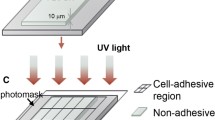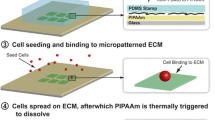Abstract
A recently developed method for surface modification, layer-by-layer (LbL) assembly, has been applied to silicone, and its ability to encourage endothelial cell growth and control cell growth patterns has been examined. The surfaces studied consisted of a precursor, with alternating cationic polyethyleneimine (PEI) and anionic sodium polystyrene sulfonate (PSS) layers followed by alternating gelatin and poly-d-lysine (PDL) layers. Film growth increased linearly with the number of layers. Each PSS/PEI bilayer was 3 nm thick, and each gelatin/PDL bilayer was 5 nm thick. All layers were more hydrophilic than the unmodified silicone rubber surface, as determined from contact angle measurements. The contact angle was primarily dictated by the outermost layer. Of the coatings studied, gelatin was the most hydrophilic. A film of (PSS/PEI)4/(gelatin/PDL)4/ gelatin was highly favorable for cell adhesion and growth, in contrast to films of (PSS/PEI)8 or (PSS/PEI)8/PSS. Cell growth patterns were successfully controlled by selective deposition of microspheres on silicone rubber, using microcontact printing with a silicone stamp. Cell adhesion was confined to the region of microsphere deposition. These results demonstrate that the LbL self-assembly technique provides a general approach to coat and selectively deposit films with nanometer thickness on silicone rubber. Furthermore, they show that this method is a viable technique for controlling cellular adhesion and growth.
Similar content being viewed by others
References
Cunningham, J. J., Nikolovski, J., Linderman, J. and Mooney, D. J. (2002) Quantification of fibronectin adsorption to silicone-rubber cell culture substrates. Biotechniques 32, 876–887.
van Kooten, T. G., and von Recum, A. F. (1999) Cell adhesion to textured silicone surfaces: the influence of time of adhesion and texture on focal contact and fibronectin fibril formation. Tissue Eng. 5, 223–240.
van Kooten, T. G., Whitesides, J. F., and von Recum, A. F. (1998) Influence of silicone (PDMS) surface texture on human skin fibroblast proliferation as determined by cell cycle analysis. J. Biomed. Mater. Res. 43, 1–14.
Singhvi, R., Kumar, A., Lopez, G. P., Stephanopoulos, G. N., Wang, D. I., Whitesides, G. M., et al. (1994) Engineering cell shape and function. Science 264, 696–698.
Biebuyck, H. A. and Whitesides, G. M. (1994) Self-organization of organic liquids on patterned self-assembled monolayers of alkanethiolates on gold. Langmuir 10, 2790–2793.
Hsiue, G. H., Lee, S. D., Wang, C. C., and Chang, P. C. (1993) The effect of plasma-induced graft copolymerization of PHEMA on silicone rubber towards improving corneal epithelial cells growth. J. Biomat. Sci-Polym. Eng. 5, 205–220.
Lee, S. D., Hsiue, G. H., Kao, C. Y., and Chang, P. C. (1996) Artificial cornea: surface modification of silicone rubber membrane by graft polymerization of pHEMA via glow discharge. Biomaterials 17, 587–595.
Ai, H., Mills, D., Alexander, J., and Jones, S. (2001) Gelatin crosslinking on silicone rubber to increase endothelial cells adhesion and growth. Ann. Biomed. Eng. 29, Supp 1, S75.
Okada, T. and Ikada, Y. (1995) Surface modification of silicone for percutaneous implantation. J. Biomat. Sci-Polym. Eng. 7, 171–180.
Ingber, D. E. (1990) Fibronectin controls capillary endothelial cell growth by modulating cell shape. Proc. Natl. Acad. Sci. USA 87, 3579–3583.
Decher, G. (1997) Fuzzy nanoassemblies: toward layered polymeric multicomposites. Science 227, 1232–1237.
Lyov, Y., Decher, G., and Möhwald, H. (1993) Assembly, structural characterization and thermal behavior of layer-by-layer deposited ultrathin films of polyvinylsulfate and polyallylamine. Langmuir 9, 481–486.
Keller, S., Kim, H.-N., and Mallouk, T. (1994) Layer-by-layer assembly of intercalation compounds and superlattices on surfaces: towards molecular “beaker” epitaxy. J. Am. Chem. Soc. 116, 8817–8821.
Schlenoff, J. (1998) Redox-active polyelectrolyte multilayers. Adv. Mater. 10, 347–351.
Sullivan, D. and Bruening, M. (2001) Ultrathin, ion-selective polyimide membranes prepared from layered polyelectrolytes. J. Am. Chem. Soc. 123, 11805–11806.
Mendelson, J., Barrett, C., Chan, V., Pal, A., Mayes, A., and Rubner, M. (2000) Fabrication of microporous thin films from polyelectrolyte multilayers. Langmuir 16, 5017–5023.
Ai, H., Fang, M., Jones, S., and Lvov, Y. (2002) Electrostatic layer-by-layer nano-assembly on biological microtemplates: platelets. Biomacro-molecules 3, 560–564.
Lvov, Y. and Caruso, F. (2001) Biocolloids with ordered urease multilayer shells as enzymatic reactors. Anal. Chem. 73, 4212–4217.
Qiu, X., Leporatti, S., Donath, E., and Möhwald, H. (2001) Studies on the drug release properties of polysaccharide multilayers encapsulated ibuprofen microparticles. Langmuir 17, 5375–5380.
Lvov, Y., Ariga, K., Ichinose, I., and Kunitake, K. (1995) Assembly of multicomponent protein films by means of electrostatic layer-by-layer adsorption. J. Am. Chem. Soc. 117, 6117–6123.
Caruso, F., Niikura, K., Furlong, N., and Okahata, Y. (1997) Assembly of alternating polyelectrolyte and protein multilayer films for immunosensing. Langmuir 13, 3427–3433.
Lvov, Y., Ariga, K., Ichinose, I., and Kunitake, T. (1997) Alternate assembly of ordered multilayers of SiO2 and other nanoparticles and polyions. Langmuir 13, 6195–6203.
Lvov Y. and Decher G. (1994) Assembly of multilayer ordered films by alternating adsorption of oppositely charged macromolecules. Crystallog. Rep. 39, 628–647.
Kumar, A., Biebyck, H. A., and Whitesides, G. M. (1994) Self-organization of organic liquids on patterned self-assembled monolayers of alkanethiolates on gold. Langmuir 10, 1498.
Taniguchi, M., Pieracci, J. P., and Belfort, G. (2001) Effect of undulations on surface energy: a quantitative assessment. Langmuir 17, 4312–4315.
Sauerbrey, G. (1959) Verwendung von schwing-quartzen zur wägung dünner schichten und zur mikrowägung. Z. Physik. 155, 206–218.
Burghardt, R. C., Barhoumi, R., Lewis, E. H., Bailey, R. H., Pyle, K. A., Clement, B. A., et al. (1992) Patulin-induced cellular toxicity: a vital fluorescence study. Toxicol. Appl. Pharmacol. 112, 235–244.
Chun, J. S., Ha, M. J., and Jacobson, B. S. (1996) Differential translocation of protein kinase C epsilon during HeLa cell adhesion to a gelatin substratum. J. Biol. Chem. 271, 13008–13012.
Crawford, J. R. and Jacobson, B. S. (1998) Extracellular calcium regulates HeLa cell morphology during adhesion to gelatin: role of translocation and phosphorylation of cytosolic phospholipase A2. Mol. Biol. Cell. 9, 3429–3443.
Schmitt, J., Grünewald, T., Krajer, K., Pershan, P., Decher, G., and Löshe, M. (1993) The internal structure of layer-by-layer adsorbed polyelectrolyte films: a neutron and X-ray reflectivity study. Macromolecules. 26, 7058–7063.
Lvov, Y. (2000) Electrostatic layer-by-layer assembly of proteins and polyions, In: Lvov, Y., Möhwald, H., Dekker, M., eds. Protein Architecture: Interfacial Molecular Assembly and Immobilization Biotechnology. New York: Dekker, pp. 125–168.
Yoo, D., Shiratori, S., and Rubner, M. (1998) Controlling bilayer composition and surface wettability of sequentially adsorbed multilayers of weak polyelectrolytes. Macromolecules 31, 4309–4318.
Chen, W. and McCarthy, T. J. (1997) Layer-bylayer deposition: a tool for polymer surface modification. Macromolecules 30, 78–86.
Levasalmi, J. and McCarthy, T. J. (1997) Poly(4-methyl-1-pentene)-supported polyelectrolyte multilayer films: preparation and gas perme-ability. Macromolecules 30, 1752–1757.
Ostuni, E., Kane, R., Chen, C. S., Ingber, D. E., and Whitesides, G. M. (2000) Patterning mammalian cells using elastomeric membranes. Langmuir 16, 7811–7819.
Inerowicz, H. D., Howell, S., Regnier, F. E., and Reifenberger, R. (2002) Multiprotein immunoassay arrays fabricated by microcontact printing. Langmuir 18, 5263–5268.
Jiang, X., Zheng, H., Gourdin, S., and Hammond, P. (2002) Polymer-on-polymer stamping: universal approaches to chemically patterned surfaces. Langmuir 18, 2607–2615.
Wang, N., Ostuni, E., Whitesides, G. M., and Ingber, D. E. (2002) Micropatterning tractional forces in living cells. Cell. Motil. Cytoskeleton 52, 97–106.
Balaban, N. Q., Schwarz, U. S., Riveline, D., Goichberg, P., Tzur, G., Sabanay, I., et al. (2001) Force and focal adhesion assembly: a close relationship studied using elastic micropatterned substrates. Nat. Cell. Biol. 3, 466–472.
Author information
Authors and Affiliations
Corresponding author
Rights and permissions
About this article
Cite this article
Ai, H., Lvov, Y.M., Mills, D.K. et al. Coating and selective deposition of nanofilm on silicone rubber for cell adhesion and growth. Cell Biochem Biophys 38, 103–114 (2003). https://doi.org/10.1385/CBB:38:2:103
Issue Date:
DOI: https://doi.org/10.1385/CBB:38:2:103




